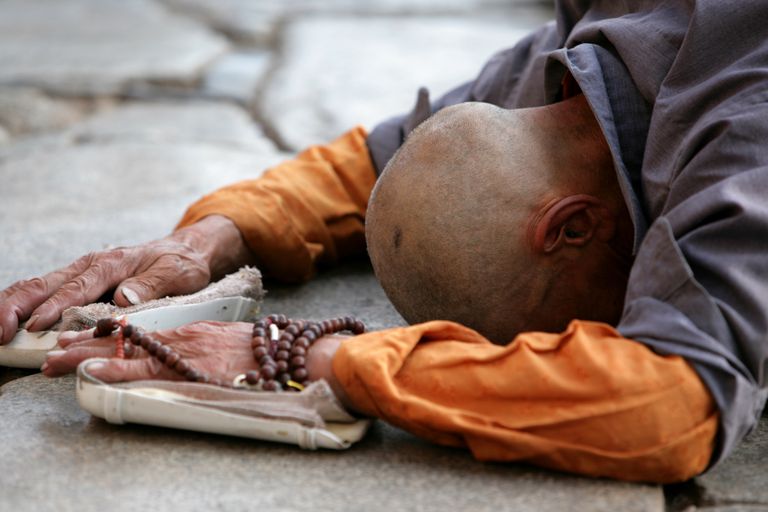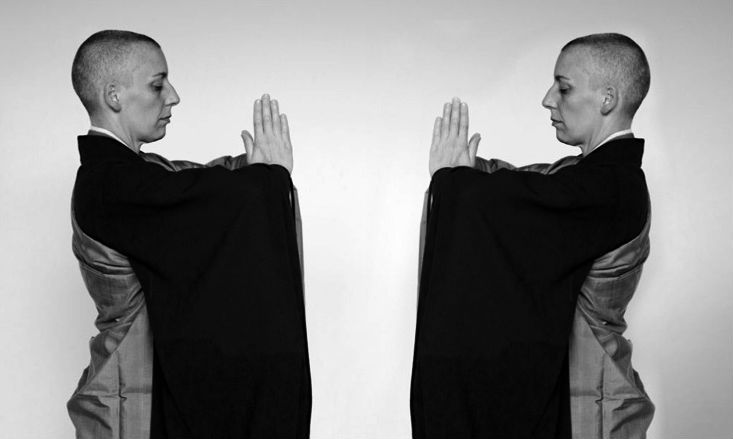The second noble truth states that suffering is caused by desire. Generally this is understood to mean that the things we want cause us suffering either by not living up to our expectations or by causing us pain when they inevitably go away.
This is an accurate assessment, and a good first step in understanding the teaching. But there is a second half. Our lack of desire can also be a cause of suffering.
For example, there are many times in life when we don’t desire to do certain things even when we know they’ll benefit ourselves and others. I experienced this early in my practice when I was learning how to bow.
Bowing at the waist or doing a full prostration, which involves going from a standing position to having ones forehead touch the floor is a major part of Buddhist practice.
A proper bow is the embodiment of humility; a literal shrinking of the physical self in deference to the universe.
Buddhists are expected to be very good at bowing. We bow to the cushion before and after meditation. We bow to statues of the Buddha, and we bow to each other. There are even stories of Zen patriarchs who regularly bowed to cats and dogs. That being said, I had great difficulty with bowing early in my practice.
I felt vulnerable and defensive each time I placed my forehead on the floor. Why was I showing so much deference to a teacher (Buddha) who’d been dead for over 2,000 years? Why was I expected to show respect to my fellow students when I barely knew them? It all seemed strange to me, and a bit silly.
But it was an important of Buddhist ritual, and no one (not even my fragile ego) was more important than that. My teacher was patient, but he made it clear that if I wanted to participate, I needed to bow alongside everyone else.
So, I did. Grudgingly, haltingly, I placed my forehead on the ground.
Initially, I did this purely out of respect for the ritual. I wanted to practice Buddhism, and this was part of it. If I didn’t like that, I could go try something else. I thought about it several times; trying something else. But I never did.
To this day, I don’t know why that is. I just know that I kept showing up to the temple, and I kept bowing in spite of my misgivings.

To this day, I don’t know why that is. I just know that I kept showing up to the temple, and I kept bowing in spite of my misgivings.
After a few years, my discomfort was replaced with habit. I stopped analyzing everything, and I simply did what was expected. When the ritual required that I bow at the waist to another student, I did. When the ritual required that I do a full prostration to the Buddha, I did.
I valued the comfort of my sangha and the continuity of ritual more than my ego, so I did what was needed. But I still didn’t want to do it. The benefits of bowing had been explained to me, and I understood them intellectually. But the desire just wasn’t there. There were two events, however, that changed everything.
The first event happened at Cloud Water Zendo during a chanting service. We were chanting The Heart Sutra (something I’ve done a million times) and one of the female monks, Ven. Shih Ming-Xing, stood up to prostrate before the Buddha (something I’ve seen a million times), but this was different.
When her forehead touches the floor; the monk, the Buddha, and the Heart Sutra were all one thing.
From this kneeling position her arms spread outwards like bird wings, tracing half circles towards the altar, the motion ended with her palms raised upwards above her head in supplication. I don’t remember her getting up.
One moment she was kneeling on the ground, the next she was standing before the altar; rooted there like some auspicious Buddhist tree. And then it was over. She returned to her place in the meditation hall, and practice continued as if nothing happened.
The next event happened during my induction ceremony at the Bright Dawn Buddhist Center. The ceremony had ended, and everyone was taking turns paying their final respects to the Buddha while the newly minted lay ministers stood to the side.
One woman stepped in front of the altar, smiled broadly as if she were meeting an old friend, and bowed at the waist. It was the most natural and joyful thing I’ve ever seen. No words were spoken, but it felt like she and Buddha had a nice little chat. Then she straightened up, nodded as if to say, “goodbye,” and walked away.
Two women, one practice, so many lessons…
The monk embodied the stillness of the absolute with her bow. And the the laywoman embodied cheerfulness of the conventional with hers. As I reflected on my own bowing practice, I wondered if I could manifest the Dharma in the same way that they did. I wondered what would happen if I really put my heart into every bow regardless of my mood or desire to do so. I didn’t know the answer. But I was willing to try.
Things were shaky in the beginning. The first time I tried to give 100% during a prostration I headbutted the floor so hard that Ven. Shih Ying Fa looked over to see if I was okay. But I stuck with it, and I improved over time.
As I did this, something changed within me. Each time I prostrated before Buddha; my hands raised in supplication, my heart softened a little bit. Every time I bowed to a fellow student I became more trusting. Yes, the practice did make me vulnerable in a very real, physical sense of the word. But that was okay.
Bowing taught me that being vulnerable is okay.

I can open myself up to the world, and nothing bad will happen; even if I do headbutt the floor. As I’ve slowly improved in the art of bowing I’ve looked for other opportunities to embody this lesson in daily life. One of the ways that I’ve found is through expressing kindness towards strangers and people I dislike.
The practice of kindness is very similar to the practice of bowing. It’s an important part of Buddhist practice, and there are many reasons why we should engage in it. But being kind to others isn’t always easy. It makes us feel vulnerable. That’s why we reserve it for people we trust.
We’re kind to family and friends because we have a reasonable belief that they’ll be kind to us. But we’re unkind or neutral towards people we don’t see as trustworthy for fear that we’ll be hurt. In other words, we lack the desire to show kindness to others for the same reason that we may not want to bow in the meditation hall.
But if we treat the act of kindness as a part of the ritual of daily life (just like bowing is part of the ritual of Buddhism), then we can do it regardless of how we feel.
We “bow” each time we smile at a coworker after we have a disagreement. We bow each time we call a friend who we haven’t spoken with in a while. And we bow each time we respond to difficult situations with kindness instead of anger.
This can be a difficult practice. In fact, it may be physically painful at times as we humble ourselves to the universe. But each time we do it our hearts soften a little bit, and we become more trusting. Of course, things won’t always go as planned, and there will be times that we make mistakes or end up feeling disappointed in the results.
But if we stick with it, then every bow will embody the stillness of the absolute. And every kind act will show the cheerfulness of the conventional; until we lose ourselves completely in the wonderful ritual of life.

